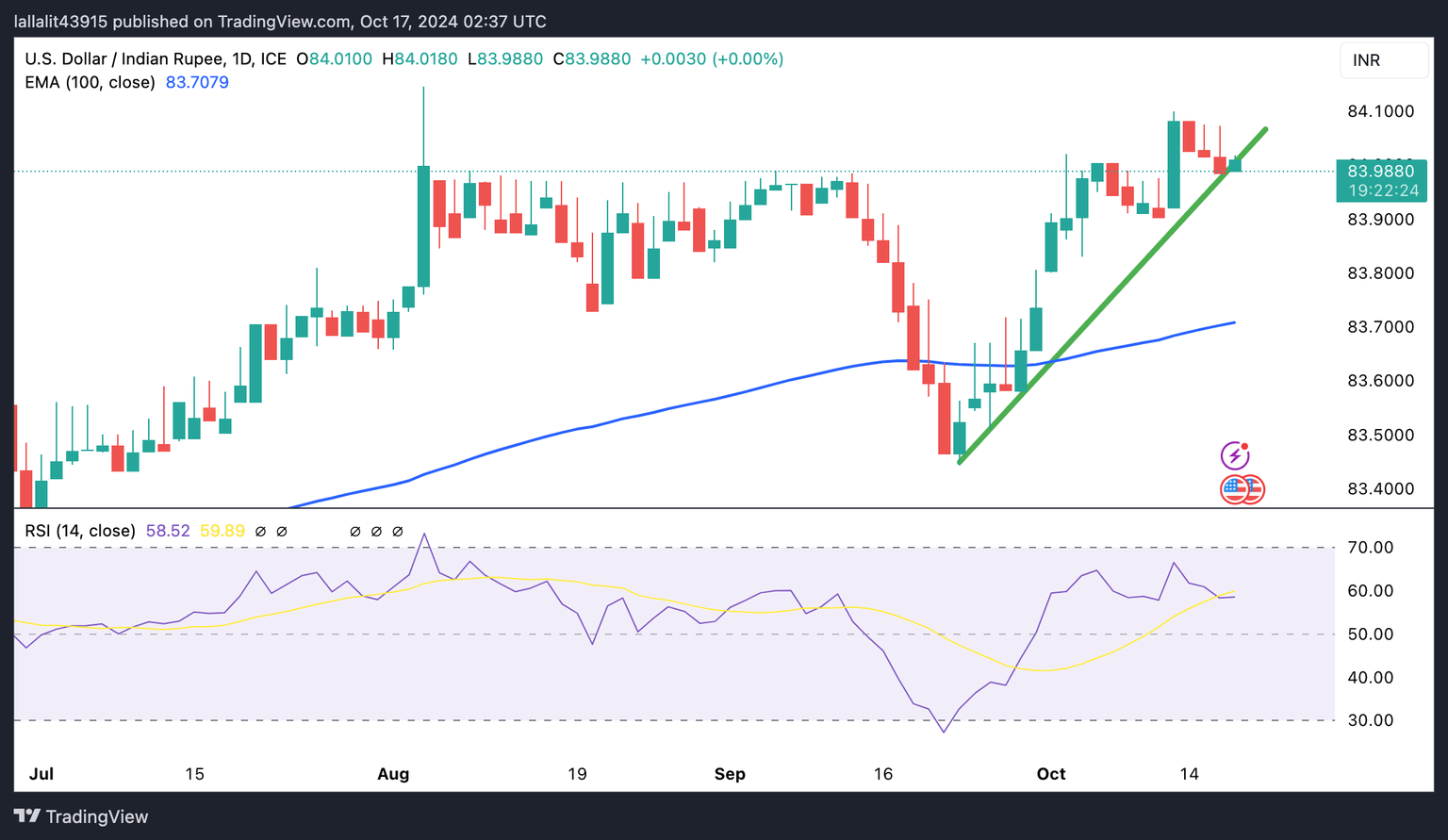USD/INR gathers strength as traders brace for US Retail Sales data
- The Indian Rupee softens in Thursday’s early European session.
- The continued selling of domestic equities by foreign portfolio investors weighs on the INR.
- The US September Retail Sales will be the highlight on Thursday.

The Indian Rupee (INR) trades with mild losses on the stronger US Dollar (USD) on Thursday. The significant outflows from Indian equities and USD demand from foreign banks and importers exert some selling pressure on the local currency.
However, the decline in crude oil prices amid easing fears over supply disruption in the Middle East might support the INR as India is the world's third-largest oil consumer. Additionally, the routine foreign exchange interventions by the Reserve Bank of India (RBI) could cap the downside for the Indian Rupee.
Traders will keep an eye on the US Retail Sales data for September, which is due later on Thursday. Also, the US weekly Initial Jobless Claims, Industrial Production and Philadelphia Fed Manufacturing Survey will be released.
Daily Digest Market Movers: Indian Rupee remains weak amid foreign fund outflows
- India’s trade deficit stood at $20.78 billion in September from $29.65 billion in August, according to data released by the commerce ministry on Wednesday.
- India’s Exports rose marginally to 34.58 billion in September from 34.41 in the year-ago period. Meanwhile, Imports declined to 55.36 billion in September versus 64.36 billion prior.
- Foreign funds withdrew more than $7 billion from Indian equities in the month through October 14, the largest in over four years, according to Bloomberg.
- The US Retail Sales is estimated to rise to 0.3% in September from 0.1% in the previous reading.
- According to the CME FedWatch tool, traders have priced in a nearly 94% chance of a 25 basis points (bps) Fed rate cut in November.
Technical Analysis: USD/INR’s constructive outlook remains intact
The Indian Rupee trades in negative territory on the day. Technically, the USD/INR pair keeps the bullish vibe as the price holds above the ascending trend line and the key 100-day Exponential Moving Average (EMA) on the daily chart. The upward momentum is supported by the 14-day Relative Strength Index (RSI), which is located above the midline near 58.80, hinting that the uptrend is more likely to gain traction than reverse.
Sustained trading above the all-time high of 84.15 could expose the pair to a possible move up to 84.50. Further north, the next upside barrier to watch is the 85.00 psychological level.
Bearish candlesticks below the rising trend line could lead to 83.90, the low of October 10. A breach of the mentioned level could pave the way to 83.70, the 100-day EMA. The next contention level is seen at 83.00, representing the round mark and the low of May 24.
Indian economy FAQs
The Indian economy has averaged a growth rate of 6.13% between 2006 and 2023, which makes it one of the fastest growing in the world. India’s high growth has attracted a lot of foreign investment. This includes Foreign Direct Investment (FDI) into physical projects and Foreign Indirect Investment (FII) by foreign funds into Indian financial markets. The greater the level of investment, the higher the demand for the Rupee (INR). Fluctuations in Dollar-demand from Indian importers also impact INR.
India has to import a great deal of its Oil and gasoline so the price of Oil can have a direct impact on the Rupee. Oil is mostly traded in US Dollars (USD) on international markets so if the price of Oil rises, aggregate demand for USD increases and Indian importers have to sell more Rupees to meet that demand, which is depreciative for the Rupee.
Inflation has a complex effect on the Rupee. Ultimately it indicates an increase in money supply which reduces the Rupee’s overall value. Yet if it rises above the Reserve Bank of India’s (RBI) 4% target, the RBI will raise interest rates to bring it down by reducing credit. Higher interest rates, especially real rates (the difference between interest rates and inflation) strengthen the Rupee. They make India a more profitable place for international investors to park their money. A fall in inflation can be supportive of the Rupee. At the same time lower interest rates can have a depreciatory effect on the Rupee.
India has run a trade deficit for most of its recent history, indicating its imports outweigh its exports. Since the majority of international trade takes place in US Dollars, there are times – due to seasonal demand or order glut – where the high volume of imports leads to significant US Dollar- demand. During these periods the Rupee can weaken as it is heavily sold to meet the demand for Dollars. When markets experience increased volatility, the demand for US Dollars can also shoot up with a similarly negative effect on the Rupee.
Author

Lallalit Srijandorn
FXStreet
Lallalit Srijandorn is a Parisian at heart. She has lived in France since 2019 and now becomes a digital entrepreneur based in Paris and Bangkok.


















